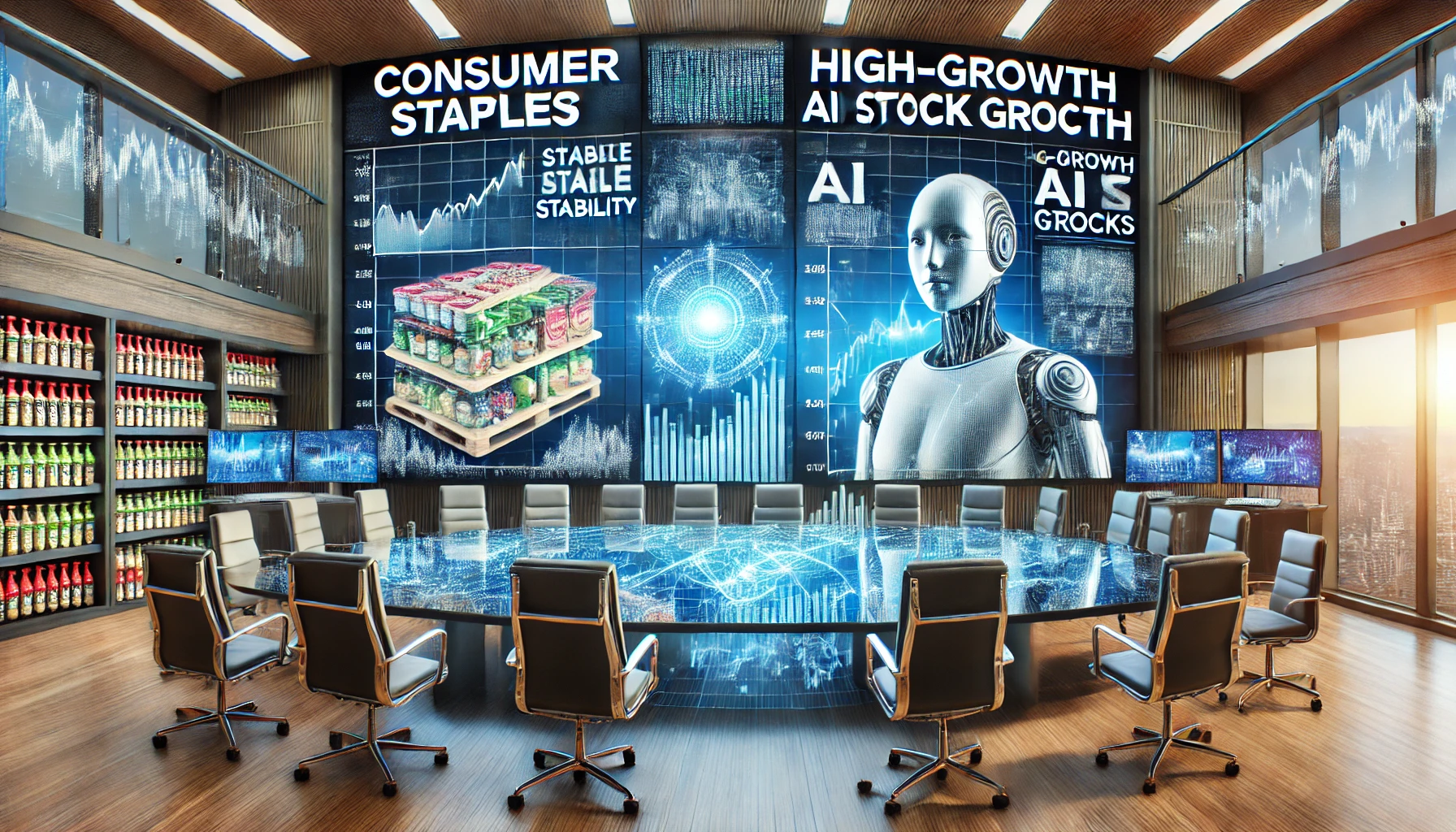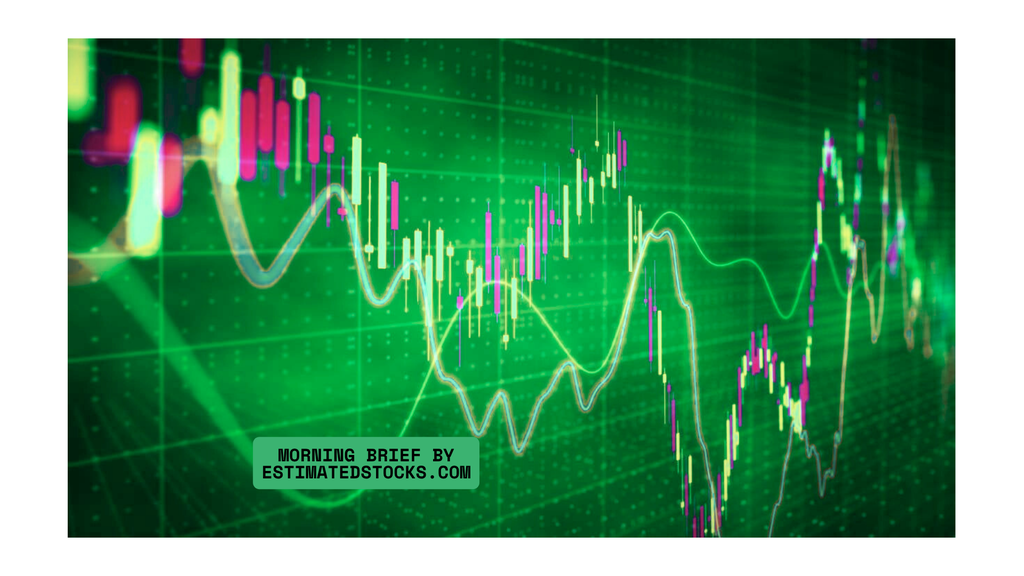
Explore the balance between stable consumer staples and high-growth AI stocks, offering insights on navigating market trends and investment strategies.
Market Trends: Consumer Staples vs. Discretionary Stocks and the Impact of AI on Market Sentiment
Stock markets have recently seen record highs, but a shift in investor behavior reveals growing caution, particularly towards consumer-related sectors. Companies that sell essential goods, known as consumer staples, are outperforming those offering non-essential, discretionary items. This trend is apparent across both equity and bond markets, where staples continue to see increased demand. Simultaneously, the rapid growth and influence of artificial intelligence (AI) have reignited tech stocks, adding an additional layer of complexity to market dynamics.
This analysis will explore the contrasting performance of consumer staples and discretionary sectors while factoring in the renewed enthusiasm around AI-driven stocks, which has contributed to the broader market rally, particularly in tech-heavy regions like Asia.
Consumer Staples: A Safe Haven Amid Economic Uncertainty
In recent months, the consumer staples sector has been a strong performer within the S&P 500, outpacing consumer discretionary stocks. This reflects a broader market sentiment where investors are seeking safety and stability in the face of economic uncertainty. Consumer staples, comprising companies that sell essential goods such as food, beverages, and household items, tend to be more resilient in periods of economic slowdown.
One of the key indicators of this sector's performance is the price-to-earnings (P/E) ratio. The P/E ratio for the S&P 500 Consumer Staples Index has risen above its five-year average, a signal that investors are willing to pay a premium for the security that these companies offer. On the other hand, the Consumer Discretionary sector’s P/E remains below its recent mean, reflecting a more pessimistic outlook on the growth potential of companies that rely on consumer spending for non-essential items.
Discretionary Sector: Impact of Key Players and Volatility
While consumer staples are benefiting from their defensive nature, the discretionary sector is facing challenges. Companies within this category offer goods and services that consumers typically purchase when they have extra disposable income, such as cars, luxury goods, and entertainment. Economic uncertainty, inflation, and changes in consumer spending habits have weighed on these companies’ prospects.
One notable example is Tesla, a major player in the discretionary sector, which holds a 14% weight in the Consumer Discretionary index. Tesla’s stock has been highly volatile this year, with a modest year-to-date increase of only 2%. Given Tesla's substantial influence on the sector, its performance has contributed to the overall underperformance of consumer discretionary stocks.
This trend extends beyond the stock market and into the bond market as well. Bonds issued by consumer staples companies have rallied more strongly than those from discretionary firms, particularly in the high-risk CCC-rated bond group. Consumer staples bonds are also outperforming within the BB-rated category, further underscoring the risk-averse sentiment of investors. In contrast, discretionary bonds are trading at steeper discounts, reflecting concerns over consumer demand and spending.
The Labor Market and Consumer Spending Concerns
A key driver of this divergence between consumer staples and discretionary stocks is the state of the labor market. While employment numbers have remained relatively strong, there are signs that the labor market is softening. This weakening could have significant implications for consumer spending, particularly on non-essential items. Investors are growing increasingly cautious about the ability of consumers to maintain current spending levels, especially in the face of rising inflation and potential job losses.
As consumer spending moderates, companies selling essential goods have an advantage. Demand for food, beverages, and household products remains relatively stable, regardless of broader economic conditions. On the other hand, discretionary companies are more vulnerable to shifts in consumer sentiment, making them a riskier investment in uncertain times.
AI and Its Impact on Tech Stocks
While consumer staples provide stability, technology stocks have reignited market momentum, largely due to advancements in artificial intelligence (AI). AI is proving to be a key growth driver in markets, especially in tech-heavy regions such as Japan, South Korea, and the United States.
On a recent trading day, Asian markets rallied as the influence of AI spread, boosting investor confidence in technology stocks. The tech-heavy Nasdaq 100 in the U.S. also saw significant gains, fueled by optimism around AI advancements and the strong performance of companies like Micron Technology. Micron, a leading U.S. producer of memory chips, surged after releasing better-than-expected sales and profit forecasts, driven by demand for AI-related equipment. This reflects the growing importance of AI in driving future technology and business innovation.
AI’s influence extends beyond hardware companies like Micron. News that OpenAI, one of the leading AI companies, is considering restructuring to become a for-profit business and potentially granting its CEO a 7% equity stake further highlights the growing financial stakes in the AI sector. Investors are closely watching these developments, as AI continues to reshape industries and offer new growth opportunities.
The Intersection of AI Growth and Consumer Sentiment
The excitement around AI is creating a dichotomy in market sentiment. On one hand, there is enthusiasm for technology and innovation, driving up stock prices in AI-related sectors. On the other hand, concerns about consumer spending and economic stability are pushing investors toward safer assets, such as consumer staples. This divergence reflects a broader uncertainty in the market, where the optimism surrounding AI's potential is tempered by the realities of economic challenges faced by consumers.
For investors, the appeal of AI-related stocks lies in their long-term growth potential. AI is seen as a transformative technology that will disrupt multiple industries, from healthcare to manufacturing. Companies involved in AI development or those benefiting from AI applications are viewed as having significant upside, even in the face of near-term economic headwinds.
However, this optimism must be balanced with the risk of volatility. AI stocks, like many in the tech sector, can experience sharp price swings, and their success is often tied to future developments rather than current earnings. As a result, while AI may reignite interest in tech stocks, it is unlikely to fully offset the defensive appeal of consumer staples in the current market environment.
Subsector Breakdown in Consumer Staples
A closer look at the consumer staples sector reveals that certain industries are performing particularly well. Discount stores, for instance, have posted substantial year-to-date returns of over 37%. This indicates that consumers are shifting toward value-based spending, a trend that benefits companies offering affordable essential goods.
Other subsectors, such as tobacco and non-alcoholic beverages, have also seen positive returns, with tobacco stocks rising nearly 27% year-to-date. These industries tend to be less sensitive to economic cycles, as demand for their products remains steady even during downturns.
However, not all areas within consumer staples are thriving. Farm products, for example, have posted negative returns, reflecting broader challenges in the agricultural sector. Additionally, companies in the wine and distillery space have struggled, with returns plummeting in the face of changing consumer preferences and supply chain disruptions.
Author's Analysis: Navigating the Market Landscape
In today's financial markets, two distinct forces are influencing investor behavior: growing caution around consumer activity and rising enthusiasm for AI-driven innovation. On one hand, the strong performance of the consumer staples sector clearly demonstrates that investors are gravitating toward safer options, particularly in light of economic uncertainty. This sector offers stability through companies providing essential goods, where demand remains consistent, regardless of economic conditions. The fundamentals of these companies are solid, with predictable cash flows and stable earnings, making them a reliable choice during periods of volatility.
On the other hand, the rapid ascent of AI-driven stocks is reshaping the future landscape of technology and innovation. AI is revolutionizing industries across the board, from healthcare to manufacturing, and its impact is reflected in the market's excitement over technology stocks, particularly in regions with a heavy tech focus, like the U.S. and Asia. Investors are drawn to the long-term growth potential that AI offers, as companies leveraging this technology are expected to become key players in tomorrow's economy.
However, it’s essential for investors to strike a careful balance between these two contrasting forces. While AI promises high growth, it is often accompanied by short-term risks and volatility. Tech stocks, especially those tied to AI advancements, can experience significant price swings, driven by market speculation and future expectations rather than current performance. This makes them a potentially risky investment in the short term, despite their exciting long-term prospects.
On the other side, while consumer staples provide a more defensive investment strategy, their upside remains limited compared to high-growth sectors like technology. These companies, although stable, are less likely to offer the explosive returns seen in sectors driven by innovation and technological advancements.
Given these opposing market dynamics, diversification across sectors appears to be a prudent approach for investors. By spreading investments between the stable, income-generating consumer staples and the high-growth potential of technology, particularly AI, investors can create a balanced portfolio. This approach allows them to benefit from the security of essential goods while also participating in the future growth opportunities presented by emerging technologies. Diversification helps mitigate the risks inherent in any one sector and ensures exposure to both stability and innovation in a rapidly changing market environment.
Disclaimer:
The information provided in this article is for educational purposes only and should not be construed as investment advice. estima...
Author
The Editorial Team at estimatedstocks.com is a dedicated group of financial market analysts, researchers, and writers committed to providing accurate, timely, and insightful content for investors and financial enthusiasts. With a deep understanding of global markets, macroeconomic trends, and investment strategies, the team at estimatedstocks.com ensures that readers are well-informed to make smart financial decisions. Our editorial team specializes in analyzing stock performance, market trends, and economic indicators, offering expert commentary and in-depth reports on the ever-evolving world of finance. We aim to bridge the gap between complex financial data and practical investment insights, making the markets accessible to everyone—from seasoned investors to those just starting their financial journey. At estimatedstocks.com, our content is driven by thorough research, critical analysis, and a commitment to delivering objective, fact-based reports. Whether it’s stock market forecasts, company earnings reviews, or sector-specific deep dives, the Editorial Team is focused on helping our audience navigate the financial landscape with confidence. Our mission is to empower investors by providing them with the tools and knowledge to make informed decisions in an unpredictable market.


